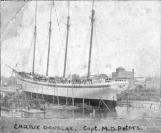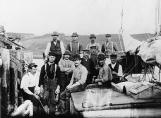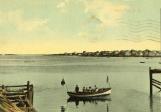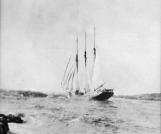1
The view from Tiverton Harbour, looking north towards Boar's Head c. 19101910
Tiverton, Nova Scotia, Canada

2
At the time that this picture was taken in the early 1900s, Tiverton, Long Island, Nova Scotia, Canada had been settled for over 117 years. Settled by loyalists who made their living from both the water and the tilling the soil, at one time it was a booming village with over 12 different stores and close to 10 different fish plants. The population was between eight hundred to one thousand people with very few unemployed. Life was difficult when viewed through the eyes of someone who lived one hundred years later, but perhaps the people then felt that life was that much better, and easier, than what their grandparents enjoyed.4
Freeport, Long Island, Nova Scotia, Canada also was a prosperous and busy seaport. Large vessels, many of them constructed within thevillage itself traded world wide. Close to one thousand people lived within the village and most of them were employed directly in connection with the catching, processing and selling of fish and fish products. There were several village shops, and what couldn't be purchased or made there could be obtained through mail order, or through trade with people on the "French Shore", Saint John, New Brunswick, or from the foreign ports of call that the vessels sailed to.
6
Westport, the only village on Brier Island had a population of approximately 800 people at the turn of the 20th century. It had been settled prior to the other adjacent villages by families who ventured to Nova Scotia from the New England coast to take advantage of the rich fishing in both the Bay of Fundy and St. Mary's Bay. Immigrants with Loyalist roots,as well as British citizens who came from England and Wales via the West Indes on the sailing vessels made Brier Island their home. They built sailing vessels, traded round the world and carved a living from the sea and the rocky soil they lived on.7
The schooner, Carrie Douglas, built for Capt. Maurice Peters, Westport c. 1880 in Bangor , Maine1880
Bangor, Maine, U.S.A

8
The following slides reflect the look of the boats which were used by the fishermen on Long and Brier Islands from 1875 to the period in 1910 to 1915 when the "age of sail" began to give way to motorized boats.9
Captain Holland Outhouse at the helm of his ship, A.B. Partner.1890
Tiverton, Nova Scotia, Canada

11
From the files of local scrap books kept by Islands' residents:This past week the annual salt boat arrived in Westport with Turks Island salt for the fish firms. The Maymere, owned by Sweney's, Yarmouth, N.S. arrived in Westport and left for Freeport on Friday night to unload salt there Saturday. She sailed for the home port of Yarmouth.
(no date given c. 1920 ?)
14
Schooner Curlew and Isma sailed Tuesday morning for Yarmouth for bait for a halibut trip in the bay.Schooners Nina Blanche; Utah and Eunica; Will'o-the Wisp; Restless; Mabel B.; A.B. Porter;
Trilby; Violet N.; F.Colgate; Swan and Curlew are all waiting for a change of wind.
Items in scrapbooks held by Islands Historical Society c. 1910




